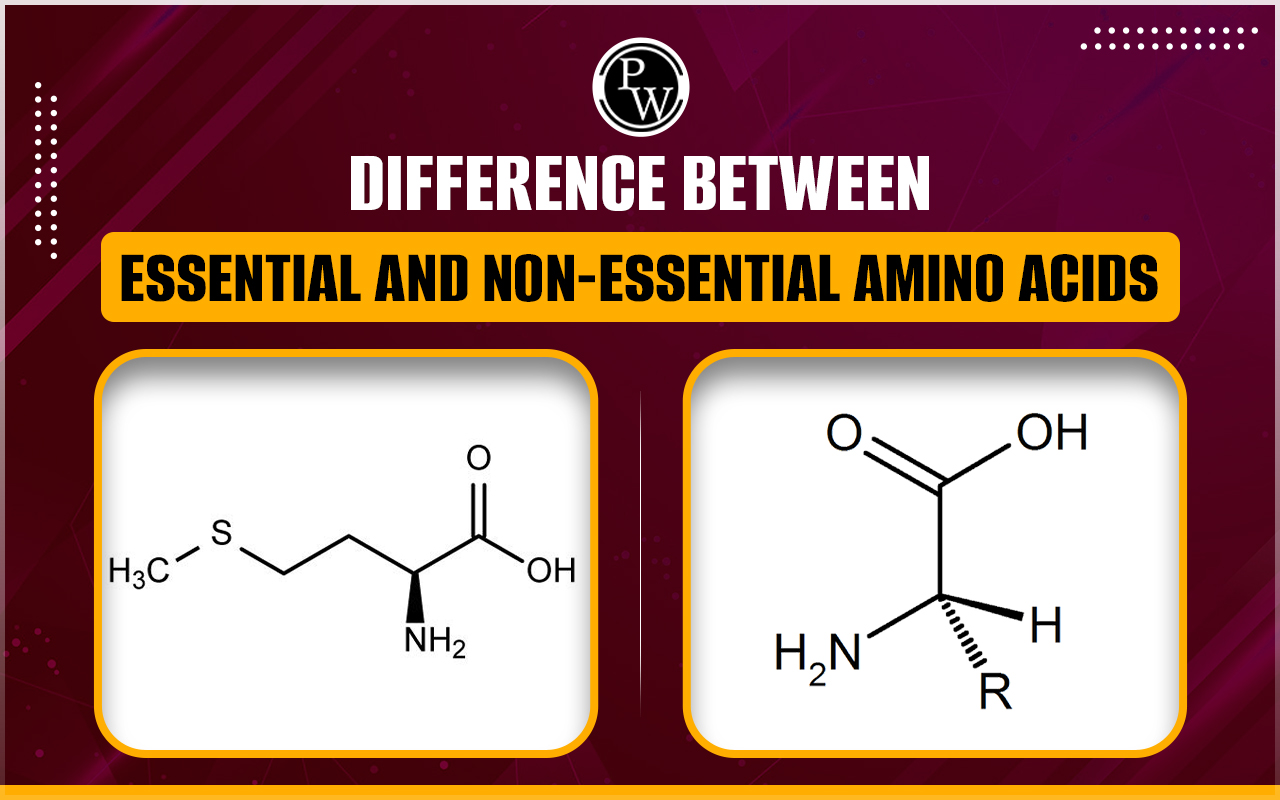

Difference Between Essential and Non-Essential Amino Acids: Amino acids are the fundamental components of proteins, enzymes, hormones, transport molecules, neurotransmitters, and other chemical substances, most of which are found in living things. 22 different amino acids may be found in nature, and they are all very tiny molecules that include nitrogen. Twenty of the 22 amino acids found in nature make up the human body.
Biochemically, essential and nonessential amino acids may be divided into two categories. The significant contrast between essential and non-essential amino acids is that while the human body can synthesise non-essential amino acids, essential amino acids must be obtained from the diet. This article will discuss the reason for the classification of amino acids, the key differences between essential and non-essential amino acids, their function in the body and their deficiency risks.Difference Between DNA and RNA
Amino Acids
Protein is synthesised from amino acids. A wide variety of proteins are in your body, each performing a vital function. Amino acid sequences differ for every protein. The protein may adopt various forms and perform various bodily tasks depending on the sequence. The Amino acids are similar to the alphabet in english. You may create new words by combining letters in various ways. Similar principles apply to amino acids; combining them in different ways may create proteins of various types.Difference Between Diapause And Hibernation
Amino Acid Structure
An amino acid is an organic material. Organic substances have bonds between carbon and hydrogen. Each amino acid has a basic structure that is the same. Each molecule comprises a central carbon atom bound to a leading amino group, a carboxylic acid group, a hydrogen atom, and an R-group, also referred to as a side-chain group. What sets amino acids distinct from one another is the R-group. The R-group of each amino acid controls its chemical structure. The structure and chemistry of an amino acid determine how it will interact with its environment and other amino acids. Peptide bonds that keep the amino acids together form proteins. After then, the forces of different amino acids and the actions of their R-groups fold the protein into exact three-dimensional shapes.Difference Between Deoxyribose and Ribose
Amino acid Types
Twenty distinct types of amino acids are required by your body to function correctly. Your body creates proteins using combinations of these 20 amino acids in various ways. Although your body produces hundreds of amino acids, it cannot produce nine amino acids necessary for survival which are called essential amino acids.Difference Between Darwinism and Lamarckism
Histidine:
Histidine is a neurotransmitter (brain chemical) precursor known as histamine. Histamine profoundly impacts the breakdown of food, the immunological system, sleep, and reproductive health.Isoleucine:
Isoleucine affects the immune system and muscle metabolism in your body. It also aids in energy regulation and haemoglobin synthesis in the body.Leucine:
Leucine helps your body produce growth hormones and protein. It aids in wound healing, blood sugar regulation, muscle growth and repair, and tissue regeneration.Lysine:
Lysine is necessary for the synthesis of both hormones and energy. Additionally, it's crucial for calcium and immune system health.Difference Between Centipede And Millipede
Methionine:
Methionine aids in your body's metabolism, detoxification, and tissue development. The essential minerals zinc and selenium are among those that methionine aids in absorption.Phenylalanine:
Phenylalanine is necessary for synthesising chemical messengers in your brain, such as dopamine, adrenaline, and norepinephrine. Additionally, it's critical for the creation of other amino acids.Threonine:
Threonine is essential for the production of collagen and elastin. These proteins structurally support your skin and connective tissue. They also aid in forming blood clots, which aid in stopping bleeding. Both your immune system and the metabolism of fat depend heavily on threonine.Tryptophan:
Tryptophan helps in preserving the ideal nitrogen balance in your body. Serotonin is a neurotransmitter that is created as a result of it. Your mood, hunger, and sleep are all regulated by serotonin.Valine:
Valine contributes to energy production, tissue regeneration, and muscular development. Human bodies can synthesise amino acids classified as non-essential. The majority of them are made with glucose. Both plant and animal items in the diet include them. Non-essential amino acids serve similar purposes to those of essential (limited) amino acids.Alanine
When you exercise vigorously, harmful chemicals produced from muscle protein breakdown are removed by alanine. Chronic weariness is a side effect of having too much alanine in the body.Difference Between Chromosome and Chromatid
Cysteine
A protein type that is prevalent in hair, nails, and skin is made up of cysteine. When combined with other antioxidants like vitamin E and selenium, it functions as an antioxidant (a scavenger of free radicals) and has a synergistic effect.Cystine
Cystine, like cysteine, helps eliminate toxins and create skin.Glutamine
Healthy brain function is encouraged by glutamine. The production of RNA and DNA molecules also depends on it.Glutathione
Antioxidant glutathione has a preventative impact on ageing. It aids in the elimination of poisons.Serine
Serine contributes to the production of immune system proteins and is a component of brain proteins. Additionally beneficial for muscular building. For sources of serine, see here.Taurine
Taurine is required to synthesise amino acids and normal brain function. It helps absorb minerals like magnesium, calcium, and potassium.Threonine
The body's protein levels are balanced by threonine. It enhances immunological function. Additionally, it helps with collagen and dental enamel formation.Difference Between Cross Pollination and Self Pollination
Asparagine
Asparagine helps balance the state of mood and supports balance in the central nervous system.Aspartic acid
Aspartic acid improves endurance, helps the body rid itself of toxins and ammonia, and is helpful in the creation of immune system-related proteins.Proline
Proline is involved in intracellular signalling.L-arginine
L-arginine aids in blood vessel relaxation, ejaculate production, and the elimination of extra ammonia from the body in males. Arginine is referred to be a semi-essential amino acid since it is not necessary for healthy adults or newborns, but it is required for those with severely damaged health.Difference Between Centipede And Millipede
Conditionally Essential amino acids
Some amino acids that aren't necessary are categorised as conditionally essential. These are only necessary for specific situations, such as illness, pregnancy, early childhood, or trauma. For instance, arginine is regarded as non-essential. Still, while recovering from a significant injury or battling certain illnesses like cancer, your body can't produce as much as you require. Because of this, individuals may occasionally take arginine supplements to fulfil their bodies' nutritional requirements. A pregnant person requires more of several amino acids, such as glycine and arginine, to maintain both their health and the health of the foetus. These amino acids are also regarded as conditionally necessary during pregnancy.Related Links -
Amino Acids and Proteins
- In nature, there is a dependent link between proteins and amino acids. To make polymers, amino acids join with other molecules to form monomers. When amino acids bind, they create polypeptide chains of at least twenty amino acids or longer, which may subsequently fold to form proteins. Some original genetic information extracted from DNA is the foundation for amino acid sequences.
- Sections of the genetic code are replicated inside the cell nucleus and then transmitted by messenger RNA to the cell cytoplasm during protein production. Once messenger RNA (mRNA) has been fixed between a ribosome's big and tiny components, it is replicated. Transfer RNA makes it feasible for this to happen.
- An amino acid is joined to transfer RNA (tRNA). Tens to hundreds of codons, or clusters of three nucleotides that together encode one amino acid, are found on an mRNA strand. Transfer RNA attaches its connected amino acid to the ribosome when it recognises a codon, where it joins with the preceding amino acid to create a chain.
- Depending on the amount of folding, proteins can have primary, secondary, tertiary, or quaternary structures.
- Peptide bonds formed by the two ribosome components alone make up the primary structure.
- Hydrogen bonds that result in segments of spirals that compress the initial chain structure are referred to as secondary structures.
- The tertiary structure adds salt bridges, more hydrogen bonds, and disulfide bonds to compress the package further.
- As its name implies, the quaternary structure consists of two or more polypeptide chains that work together to form a single unit or multimer.
Difference Between Ectomycorrhizae and Endomycorrhizae
Difference Between Essential and Nonessential Amino Acids
| Essential Amino acids | Non-Essential Amino acids |
| These amino acids must be taken from our food, and the body cannot synthesise them. | The body can synthesise these amino acids; taking them from the diet is unnecessary. |
| Examples: Isoleucine, leucine, threonine, phenylalanine, valine, etc. | Examples: Alanine, arginine, aspartic acid, glutamic acid, proline, glycine, serine, tyrosine, and cysteine, etc. |
| It helps repair muscle tissues and forms a precursor for the formation of brain neurotransmitters. | It helps in the removal of toxins, synthesis of RBC and Wbs, promotion of the function of the brain, etc. |
| There are a total of 9 essential amino acids. | The human body requires a total of 11 non-essential amino acids. |
| They must be consumed from food or external source. | They are produced within the body by themselves. |
Difference Between Essential And Non-Essential Amino Acids FAQs
Write the names of essential and non-essential amino acids.
What is the function of amino acids in our body?
What are some familiar food sources containing amino acids?
Are amino acids alkaline or acidic?












